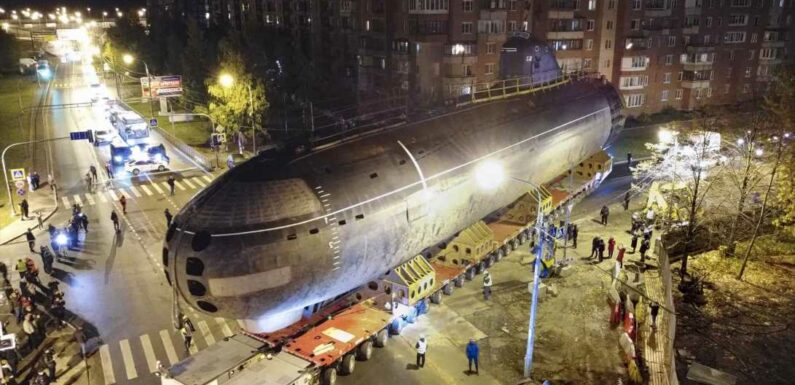
THIS is the extraordinary moment a 3,000-ton nuclear submarine was paraded through the streets of Russia.
Built in 1957, the K-3 Leninsky Komsomol was the Soviet Union's first nuclear sub – and it's now set to become a museum in the city of Kronstadt, near St Petersburg.
The whopping 352ft-long submarine was paraded through the city on Wednesday on its journey to the site where it will be assembled with the stern and transformed into a museum.
The project has been in the works for years at the Nerpa shipyard.
With the hull repaired and the radioactive parts of the reactors taken out, the vessel is now ready to take shape as a museum for visitors to see the beast up close.
K-3, which was was prototyped in wood, was built in Molotovsk and floated out for the first time in 1957.
Read more on Russia
Be ready for NUCLEAR WAR if Putin’s army collapses, warns ex-Nato chief
Russia drags Belarus into Ukraine invasion as it runs out of missiles
A year later, the sub was commissioned and sailed to Zapadnaya List on the Kola Peninsula in the northwest of Russia.
In June 1962, it became the first Soviet vessel to break through the ice in the North Pole in a huge milestone for the bloc.
Powered by two water-cooled reactors, the vessel – the third nuclear sub in the world – became a symbol of the Soviet Union's underwater warfare capabilities.
The captain of K-3, Lev Mikhailovich Zhiltsov, was awarded the title Hero of the Soviet Union for the mission – the highest award in the USSR.
Most read in News
Human remains found in search for Leah Croucher 3 years after she vanished
Nurse 'smiled at mum of baby she killed on 4th attempt & sent sympathy card'
I was dead for 90 minutes – here’s what I saw as medics tried to save me
Major change to school hours needed, urges children's tsar
For her North Pole achievement, K-3 was given the title Leninsky Komsomol.
Four years later, in the summer of 1967, K-3 was also given the mission of following an American ballistic missile submarine.
But disaster struck just months later when 39 crew members died on board after a fire started in the vessel's hydraulic system while sailing through the Norwegian Sea.
Rather than spraying water, a carbon dioxide-type gas filled the first and second compartments, killing dozens of crew members.
When the dividing door in the bulkhead from the third compartment was opened, the gas spread, and more people died.
Awards were recommended for the crew after the tragedy, including seven nominations for the Hero of the Soviet Union.
But an investigation into the blaze found a lighter in the torpedo compartment and found the position of a sailor's body suspicious.
They ruled that the sailor's smoking had sparked the fire.
Four days after the tragedy, K-3 returned to base.
Despite extensive fire damage, the sub was repaired and put back into the waters.
The vessel was officially taken out of service in 1988 after serving the Soviet Union for 30 years and moved to the Nerpa shipyard in 2005.
Read More on The Sun
Marks and Spencer to close 67 stores in branch shake-up over next five years
Thousands of families to get extra £130 help with bills
And after years of restoration, visitors are expected to be able to step foot inside the vessel at the Museum of Navy Glory in the city of Kronstadt outside St Petersburg by 2023.
The sub was originally planned to be put alongside Lenin – the Soviet Union’s first nuclear powered icebreaker – in Murmansk before the location was changed to Kronstadt, a naval base on Russia's Kotlin Island.
Source: Read Full Article










